UNICEF Brand Revitalization: Engaging New Pledge Donors
VerifiedAdded on 2023/01/19
|27
|5527
|36
Essay
AI Summary
This comprehensive essay analyzes UNICEF's brand revitalization strategy, focusing on engaging a new generation of pledge donors. The analysis begins with a situational analysis using the PEST framework to understand the political, economic, socio-cultural, and technological factors influencing UNICEF's operations. A thorough brand audit examines UNICEF's positioning, brand value, unique selling proposition, and external branding. The essay identifies the characteristics of UNICEF's contributors, including business and individual donors, and defines target customer personas. It then explores the media landscape and develops a communication strategy with specific objectives and techniques, followed by a customer journey map and evaluation metrics. Key Performance Indicators (KPIs) for growth are established, and the strategic plan is applied to the manpower outsourcing sector. The essay concludes with a summary of the findings and recommendations for UNICEF's brand revitalization.
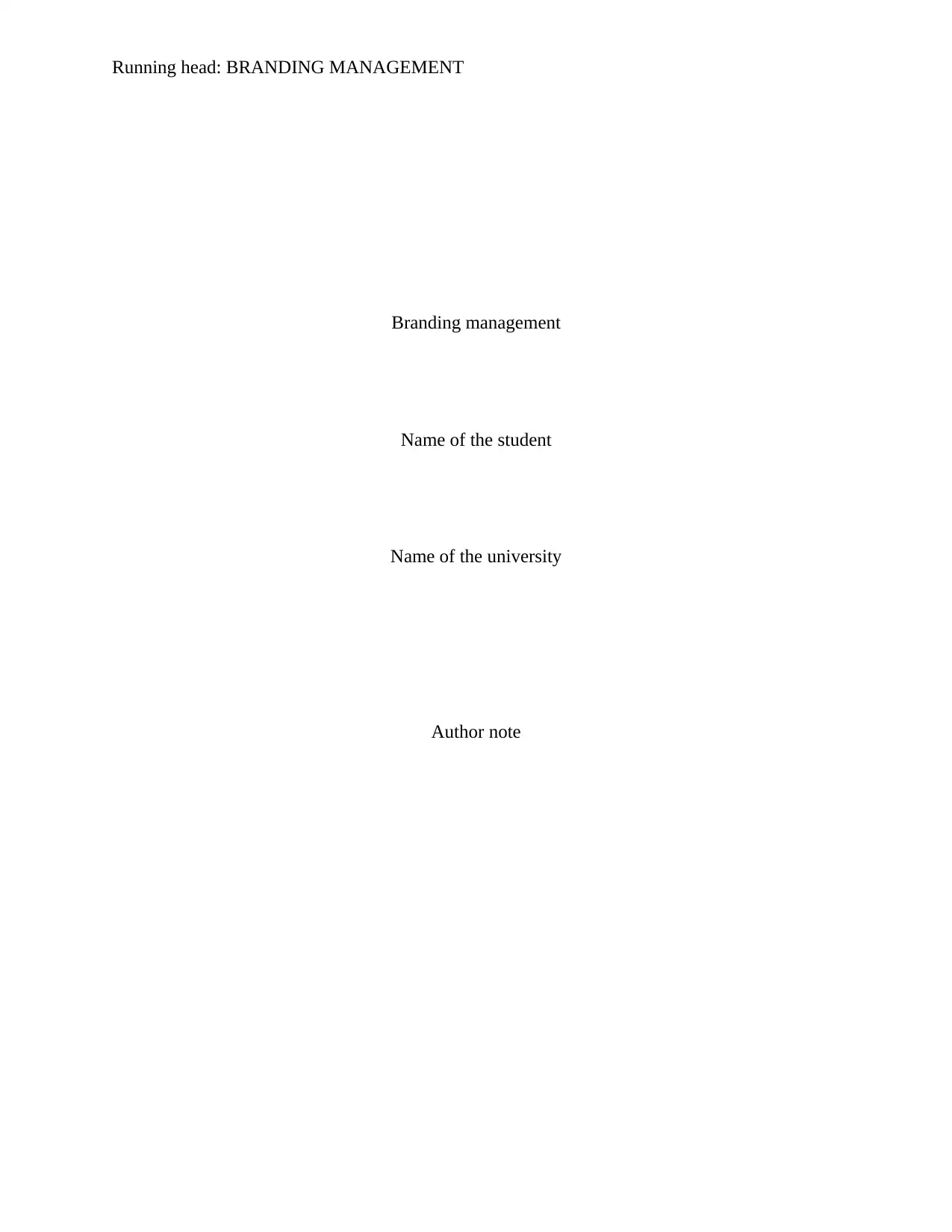
Running head: BRANDING MANAGEMENT
Branding management
Name of the student
Name of the university
Author note
Branding management
Name of the student
Name of the university
Author note
Paraphrase This Document
Need a fresh take? Get an instant paraphrase of this document with our AI Paraphraser
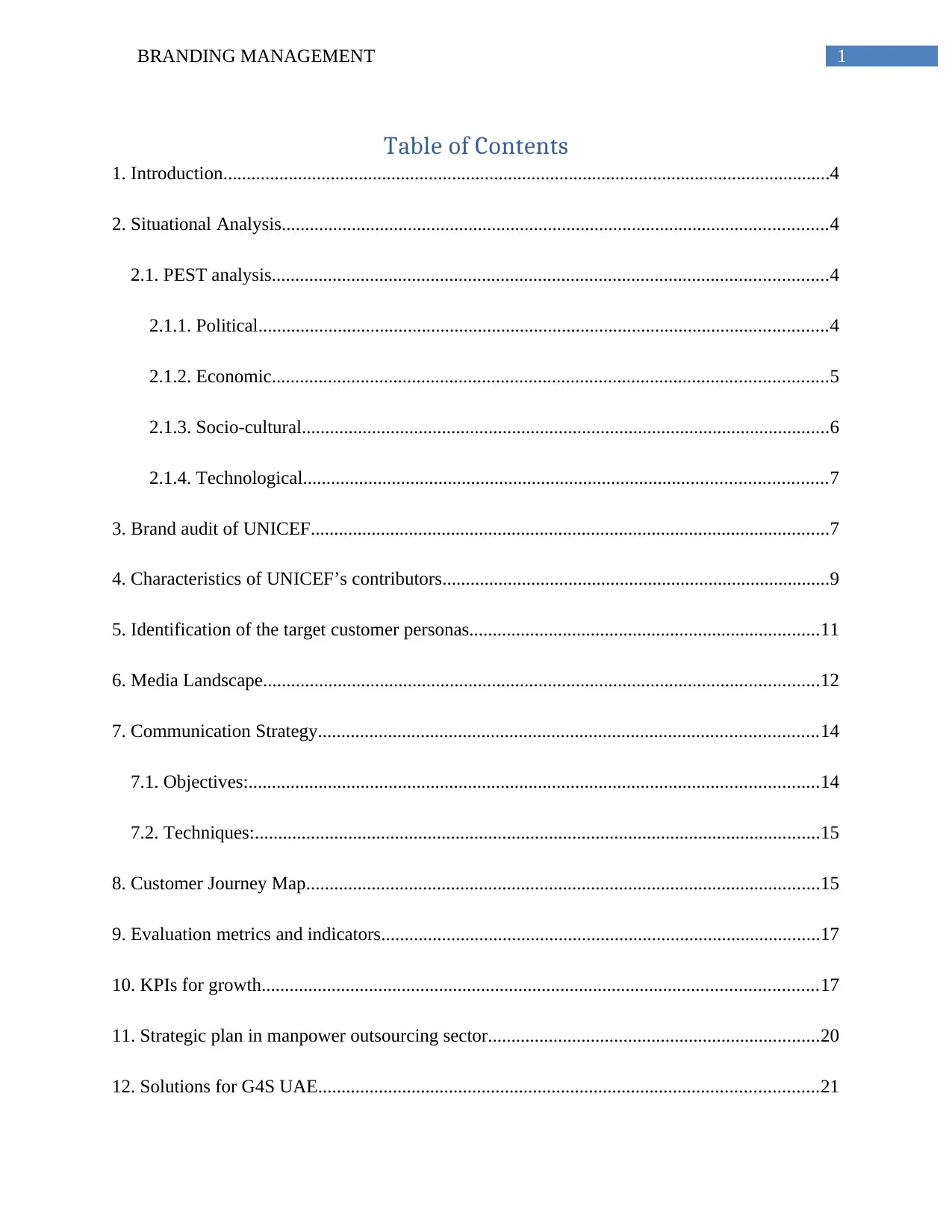
1BRANDING MANAGEMENT
Table of Contents
1. Introduction..................................................................................................................................4
2. Situational Analysis.....................................................................................................................4
2.1. PEST analysis.......................................................................................................................4
2.1.1. Political..........................................................................................................................4
2.1.2. Economic.......................................................................................................................5
2.1.3. Socio-cultural.................................................................................................................6
2.1.4. Technological................................................................................................................7
3. Brand audit of UNICEF...............................................................................................................7
4. Characteristics of UNICEF’s contributors...................................................................................9
5. Identification of the target customer personas...........................................................................11
6. Media Landscape.......................................................................................................................12
7. Communication Strategy...........................................................................................................14
7.1. Objectives:..........................................................................................................................14
7.2. Techniques:.........................................................................................................................15
8. Customer Journey Map..............................................................................................................15
9. Evaluation metrics and indicators..............................................................................................17
10. KPIs for growth.......................................................................................................................17
11. Strategic plan in manpower outsourcing sector.......................................................................20
12. Solutions for G4S UAE...........................................................................................................21
Table of Contents
1. Introduction..................................................................................................................................4
2. Situational Analysis.....................................................................................................................4
2.1. PEST analysis.......................................................................................................................4
2.1.1. Political..........................................................................................................................4
2.1.2. Economic.......................................................................................................................5
2.1.3. Socio-cultural.................................................................................................................6
2.1.4. Technological................................................................................................................7
3. Brand audit of UNICEF...............................................................................................................7
4. Characteristics of UNICEF’s contributors...................................................................................9
5. Identification of the target customer personas...........................................................................11
6. Media Landscape.......................................................................................................................12
7. Communication Strategy...........................................................................................................14
7.1. Objectives:..........................................................................................................................14
7.2. Techniques:.........................................................................................................................15
8. Customer Journey Map..............................................................................................................15
9. Evaluation metrics and indicators..............................................................................................17
10. KPIs for growth.......................................................................................................................17
11. Strategic plan in manpower outsourcing sector.......................................................................20
12. Solutions for G4S UAE...........................................................................................................21
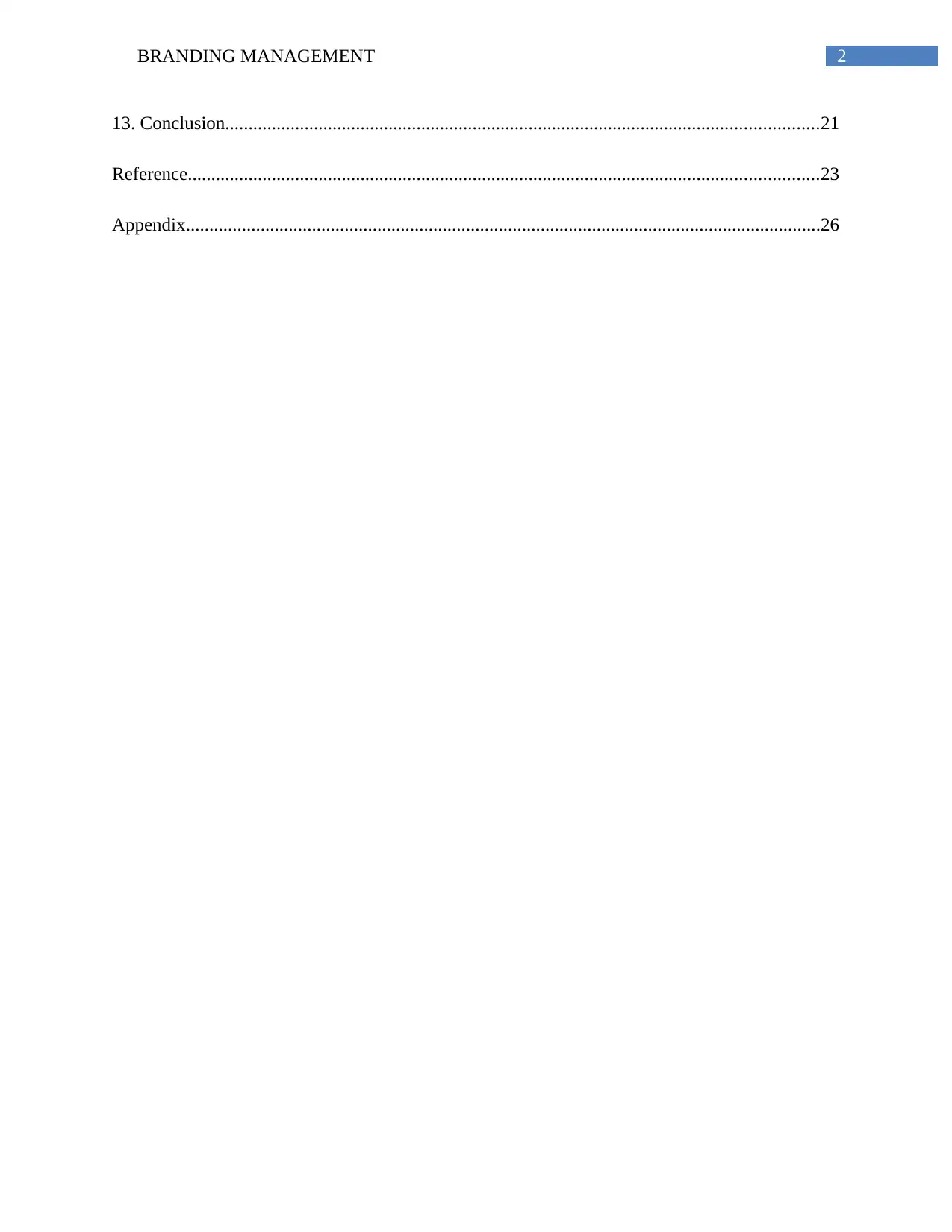
2BRANDING MANAGEMENT
13. Conclusion...............................................................................................................................21
Reference.......................................................................................................................................23
Appendix........................................................................................................................................26
13. Conclusion...............................................................................................................................21
Reference.......................................................................................................................................23
Appendix........................................................................................................................................26
⊘ This is a preview!⊘
Do you want full access?
Subscribe today to unlock all pages.

Trusted by 1+ million students worldwide
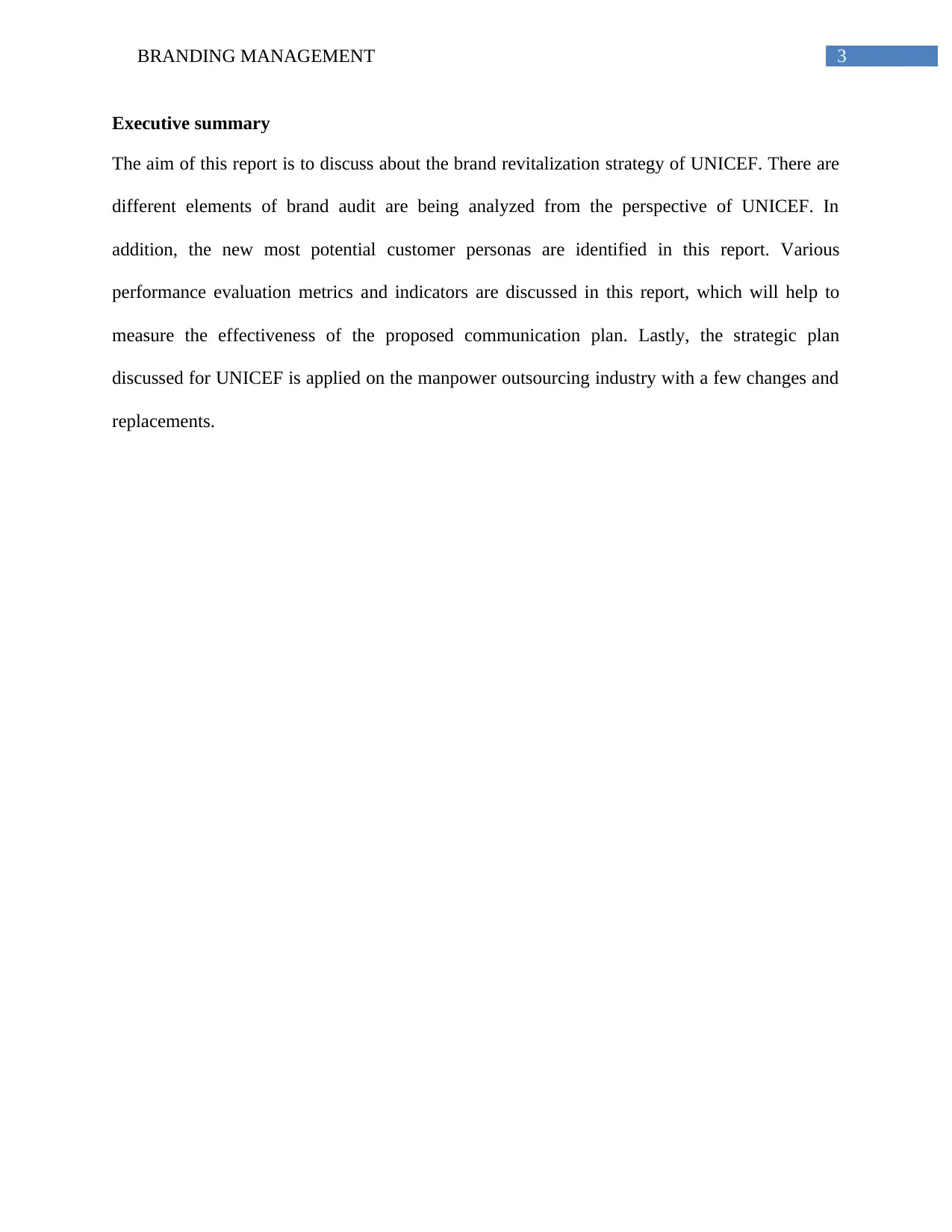
3BRANDING MANAGEMENT
Executive summary
The aim of this report is to discuss about the brand revitalization strategy of UNICEF. There are
different elements of brand audit are being analyzed from the perspective of UNICEF. In
addition, the new most potential customer personas are identified in this report. Various
performance evaluation metrics and indicators are discussed in this report, which will help to
measure the effectiveness of the proposed communication plan. Lastly, the strategic plan
discussed for UNICEF is applied on the manpower outsourcing industry with a few changes and
replacements.
Executive summary
The aim of this report is to discuss about the brand revitalization strategy of UNICEF. There are
different elements of brand audit are being analyzed from the perspective of UNICEF. In
addition, the new most potential customer personas are identified in this report. Various
performance evaluation metrics and indicators are discussed in this report, which will help to
measure the effectiveness of the proposed communication plan. Lastly, the strategic plan
discussed for UNICEF is applied on the manpower outsourcing industry with a few changes and
replacements.
Paraphrase This Document
Need a fresh take? Get an instant paraphrase of this document with our AI Paraphraser
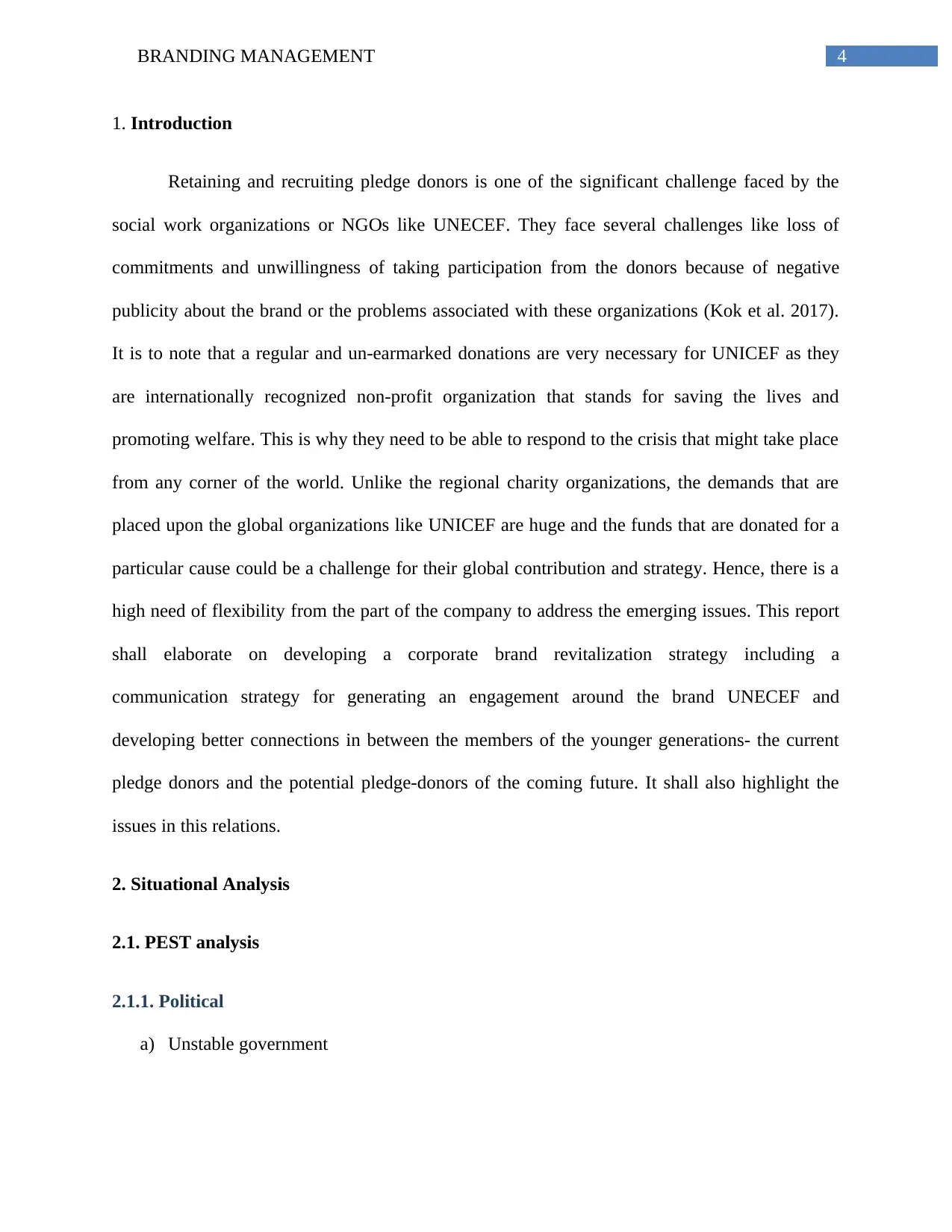
4BRANDING MANAGEMENT
1. Introduction
Retaining and recruiting pledge donors is one of the significant challenge faced by the
social work organizations or NGOs like UNECEF. They face several challenges like loss of
commitments and unwillingness of taking participation from the donors because of negative
publicity about the brand or the problems associated with these organizations (Kok et al. 2017).
It is to note that a regular and un-earmarked donations are very necessary for UNICEF as they
are internationally recognized non-profit organization that stands for saving the lives and
promoting welfare. This is why they need to be able to respond to the crisis that might take place
from any corner of the world. Unlike the regional charity organizations, the demands that are
placed upon the global organizations like UNICEF are huge and the funds that are donated for a
particular cause could be a challenge for their global contribution and strategy. Hence, there is a
high need of flexibility from the part of the company to address the emerging issues. This report
shall elaborate on developing a corporate brand revitalization strategy including a
communication strategy for generating an engagement around the brand UNECEF and
developing better connections in between the members of the younger generations- the current
pledge donors and the potential pledge-donors of the coming future. It shall also highlight the
issues in this relations.
2. Situational Analysis
2.1. PEST analysis
2.1.1. Political
a) Unstable government
1. Introduction
Retaining and recruiting pledge donors is one of the significant challenge faced by the
social work organizations or NGOs like UNECEF. They face several challenges like loss of
commitments and unwillingness of taking participation from the donors because of negative
publicity about the brand or the problems associated with these organizations (Kok et al. 2017).
It is to note that a regular and un-earmarked donations are very necessary for UNICEF as they
are internationally recognized non-profit organization that stands for saving the lives and
promoting welfare. This is why they need to be able to respond to the crisis that might take place
from any corner of the world. Unlike the regional charity organizations, the demands that are
placed upon the global organizations like UNICEF are huge and the funds that are donated for a
particular cause could be a challenge for their global contribution and strategy. Hence, there is a
high need of flexibility from the part of the company to address the emerging issues. This report
shall elaborate on developing a corporate brand revitalization strategy including a
communication strategy for generating an engagement around the brand UNECEF and
developing better connections in between the members of the younger generations- the current
pledge donors and the potential pledge-donors of the coming future. It shall also highlight the
issues in this relations.
2. Situational Analysis
2.1. PEST analysis
2.1.1. Political
a) Unstable government
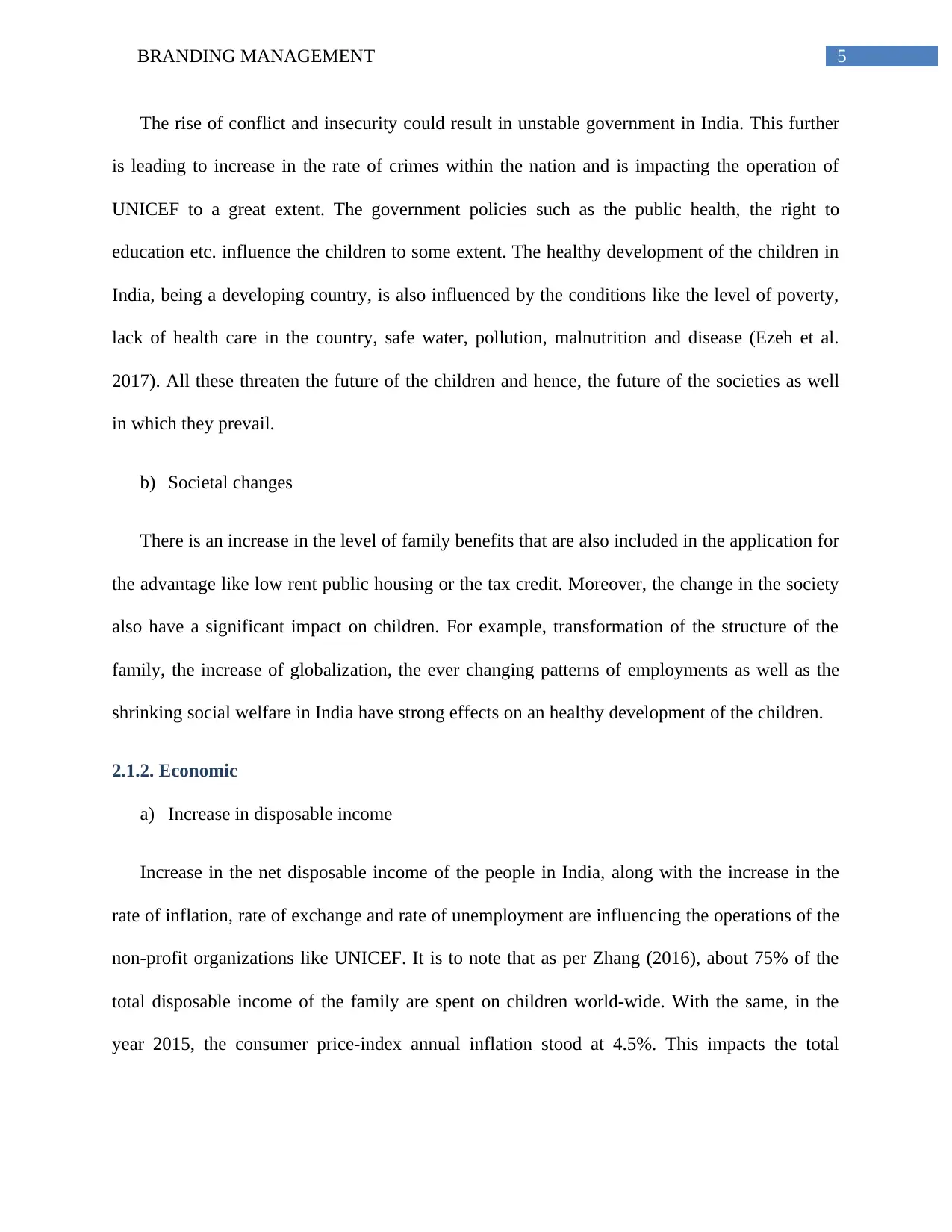
5BRANDING MANAGEMENT
The rise of conflict and insecurity could result in unstable government in India. This further
is leading to increase in the rate of crimes within the nation and is impacting the operation of
UNICEF to a great extent. The government policies such as the public health, the right to
education etc. influence the children to some extent. The healthy development of the children in
India, being a developing country, is also influenced by the conditions like the level of poverty,
lack of health care in the country, safe water, pollution, malnutrition and disease (Ezeh et al.
2017). All these threaten the future of the children and hence, the future of the societies as well
in which they prevail.
b) Societal changes
There is an increase in the level of family benefits that are also included in the application for
the advantage like low rent public housing or the tax credit. Moreover, the change in the society
also have a significant impact on children. For example, transformation of the structure of the
family, the increase of globalization, the ever changing patterns of employments as well as the
shrinking social welfare in India have strong effects on an healthy development of the children.
2.1.2. Economic
a) Increase in disposable income
Increase in the net disposable income of the people in India, along with the increase in the
rate of inflation, rate of exchange and rate of unemployment are influencing the operations of the
non-profit organizations like UNICEF. It is to note that as per Zhang (2016), about 75% of the
total disposable income of the family are spent on children world-wide. With the same, in the
year 2015, the consumer price-index annual inflation stood at 4.5%. This impacts the total
The rise of conflict and insecurity could result in unstable government in India. This further
is leading to increase in the rate of crimes within the nation and is impacting the operation of
UNICEF to a great extent. The government policies such as the public health, the right to
education etc. influence the children to some extent. The healthy development of the children in
India, being a developing country, is also influenced by the conditions like the level of poverty,
lack of health care in the country, safe water, pollution, malnutrition and disease (Ezeh et al.
2017). All these threaten the future of the children and hence, the future of the societies as well
in which they prevail.
b) Societal changes
There is an increase in the level of family benefits that are also included in the application for
the advantage like low rent public housing or the tax credit. Moreover, the change in the society
also have a significant impact on children. For example, transformation of the structure of the
family, the increase of globalization, the ever changing patterns of employments as well as the
shrinking social welfare in India have strong effects on an healthy development of the children.
2.1.2. Economic
a) Increase in disposable income
Increase in the net disposable income of the people in India, along with the increase in the
rate of inflation, rate of exchange and rate of unemployment are influencing the operations of the
non-profit organizations like UNICEF. It is to note that as per Zhang (2016), about 75% of the
total disposable income of the family are spent on children world-wide. With the same, in the
year 2015, the consumer price-index annual inflation stood at 4.5%. This impacts the total
⊘ This is a preview!⊘
Do you want full access?
Subscribe today to unlock all pages.

Trusted by 1+ million students worldwide
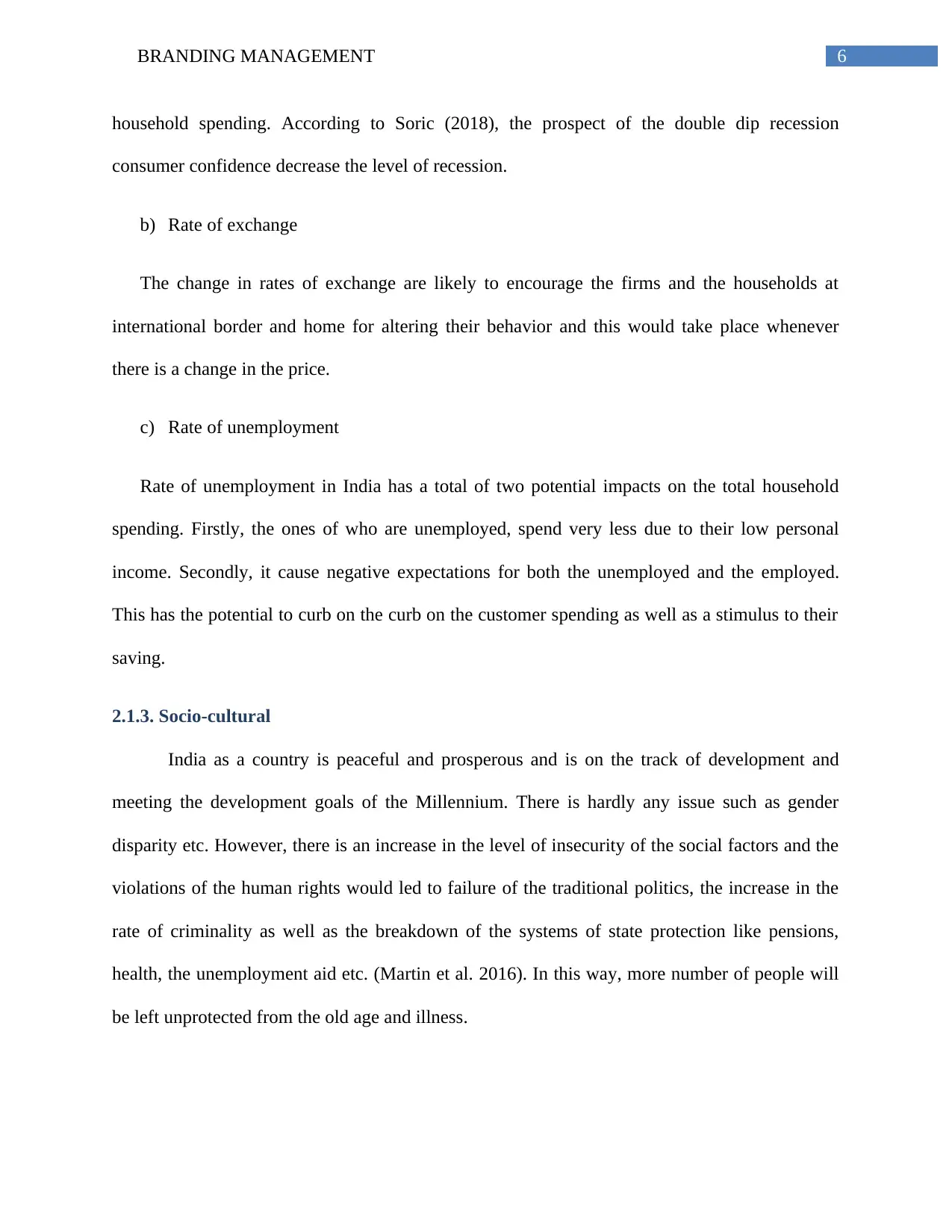
6BRANDING MANAGEMENT
household spending. According to Soric (2018), the prospect of the double dip recession
consumer confidence decrease the level of recession.
b) Rate of exchange
The change in rates of exchange are likely to encourage the firms and the households at
international border and home for altering their behavior and this would take place whenever
there is a change in the price.
c) Rate of unemployment
Rate of unemployment in India has a total of two potential impacts on the total household
spending. Firstly, the ones of who are unemployed, spend very less due to their low personal
income. Secondly, it cause negative expectations for both the unemployed and the employed.
This has the potential to curb on the curb on the customer spending as well as a stimulus to their
saving.
2.1.3. Socio-cultural
India as a country is peaceful and prosperous and is on the track of development and
meeting the development goals of the Millennium. There is hardly any issue such as gender
disparity etc. However, there is an increase in the level of insecurity of the social factors and the
violations of the human rights would led to failure of the traditional politics, the increase in the
rate of criminality as well as the breakdown of the systems of state protection like pensions,
health, the unemployment aid etc. (Martin et al. 2016). In this way, more number of people will
be left unprotected from the old age and illness.
household spending. According to Soric (2018), the prospect of the double dip recession
consumer confidence decrease the level of recession.
b) Rate of exchange
The change in rates of exchange are likely to encourage the firms and the households at
international border and home for altering their behavior and this would take place whenever
there is a change in the price.
c) Rate of unemployment
Rate of unemployment in India has a total of two potential impacts on the total household
spending. Firstly, the ones of who are unemployed, spend very less due to their low personal
income. Secondly, it cause negative expectations for both the unemployed and the employed.
This has the potential to curb on the curb on the customer spending as well as a stimulus to their
saving.
2.1.3. Socio-cultural
India as a country is peaceful and prosperous and is on the track of development and
meeting the development goals of the Millennium. There is hardly any issue such as gender
disparity etc. However, there is an increase in the level of insecurity of the social factors and the
violations of the human rights would led to failure of the traditional politics, the increase in the
rate of criminality as well as the breakdown of the systems of state protection like pensions,
health, the unemployment aid etc. (Martin et al. 2016). In this way, more number of people will
be left unprotected from the old age and illness.
Paraphrase This Document
Need a fresh take? Get an instant paraphrase of this document with our AI Paraphraser
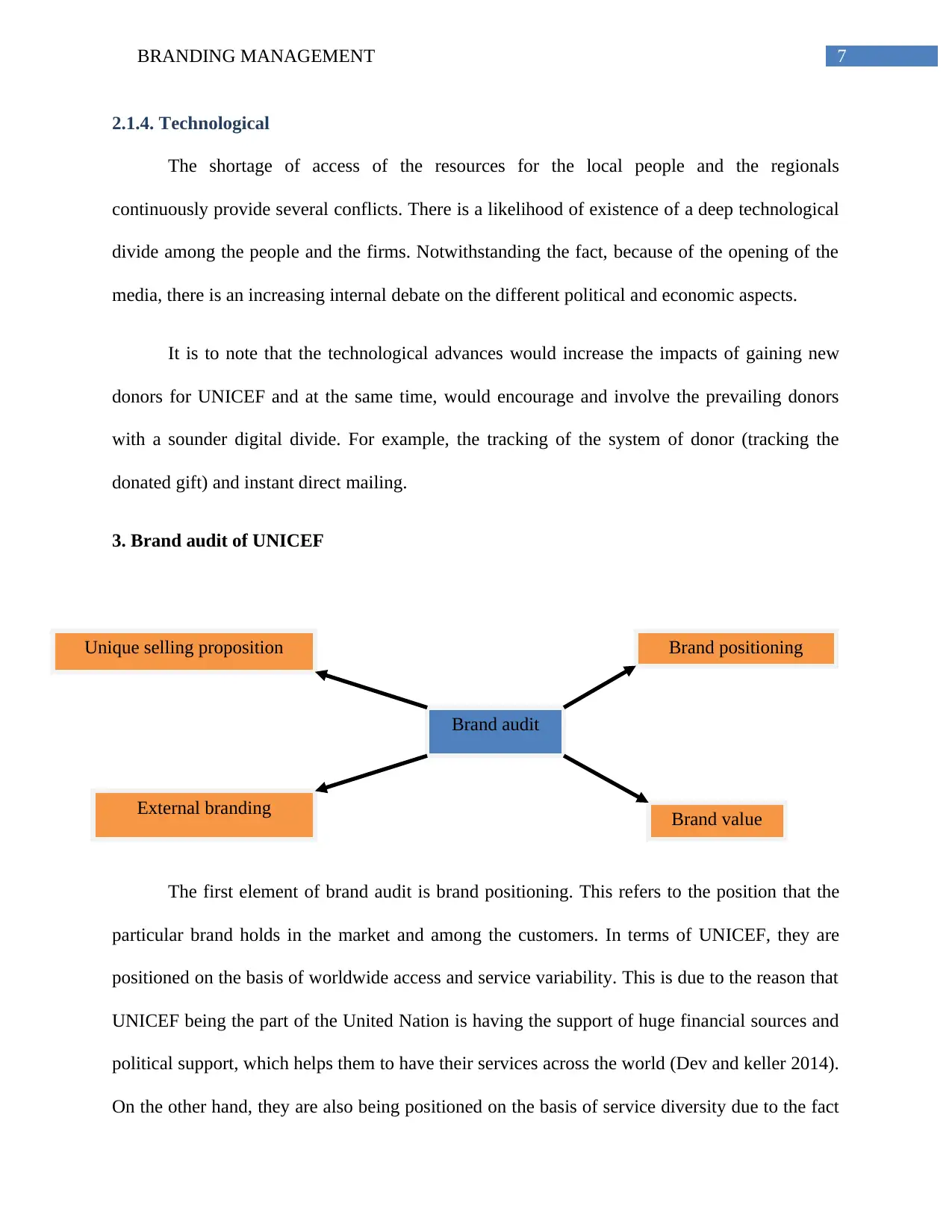
7BRANDING MANAGEMENT
Brand audit
Unique selling proposition
Brand value
Brand positioning
External branding
2.1.4. Technological
The shortage of access of the resources for the local people and the regionals
continuously provide several conflicts. There is a likelihood of existence of a deep technological
divide among the people and the firms. Notwithstanding the fact, because of the opening of the
media, there is an increasing internal debate on the different political and economic aspects.
It is to note that the technological advances would increase the impacts of gaining new
donors for UNICEF and at the same time, would encourage and involve the prevailing donors
with a sounder digital divide. For example, the tracking of the system of donor (tracking the
donated gift) and instant direct mailing.
3. Brand audit of UNICEF
The first element of brand audit is brand positioning. This refers to the position that the
particular brand holds in the market and among the customers. In terms of UNICEF, they are
positioned on the basis of worldwide access and service variability. This is due to the reason that
UNICEF being the part of the United Nation is having the support of huge financial sources and
political support, which helps them to have their services across the world (Dev and keller 2014).
On the other hand, they are also being positioned on the basis of service diversity due to the fact
Brand audit
Unique selling proposition
Brand value
Brand positioning
External branding
2.1.4. Technological
The shortage of access of the resources for the local people and the regionals
continuously provide several conflicts. There is a likelihood of existence of a deep technological
divide among the people and the firms. Notwithstanding the fact, because of the opening of the
media, there is an increasing internal debate on the different political and economic aspects.
It is to note that the technological advances would increase the impacts of gaining new
donors for UNICEF and at the same time, would encourage and involve the prevailing donors
with a sounder digital divide. For example, the tracking of the system of donor (tracking the
donated gift) and instant direct mailing.
3. Brand audit of UNICEF
The first element of brand audit is brand positioning. This refers to the position that the
particular brand holds in the market and among the customers. In terms of UNICEF, they are
positioned on the basis of worldwide access and service variability. This is due to the reason that
UNICEF being the part of the United Nation is having the support of huge financial sources and
political support, which helps them to have their services across the world (Dev and keller 2014).
On the other hand, they are also being positioned on the basis of service diversity due to the fact
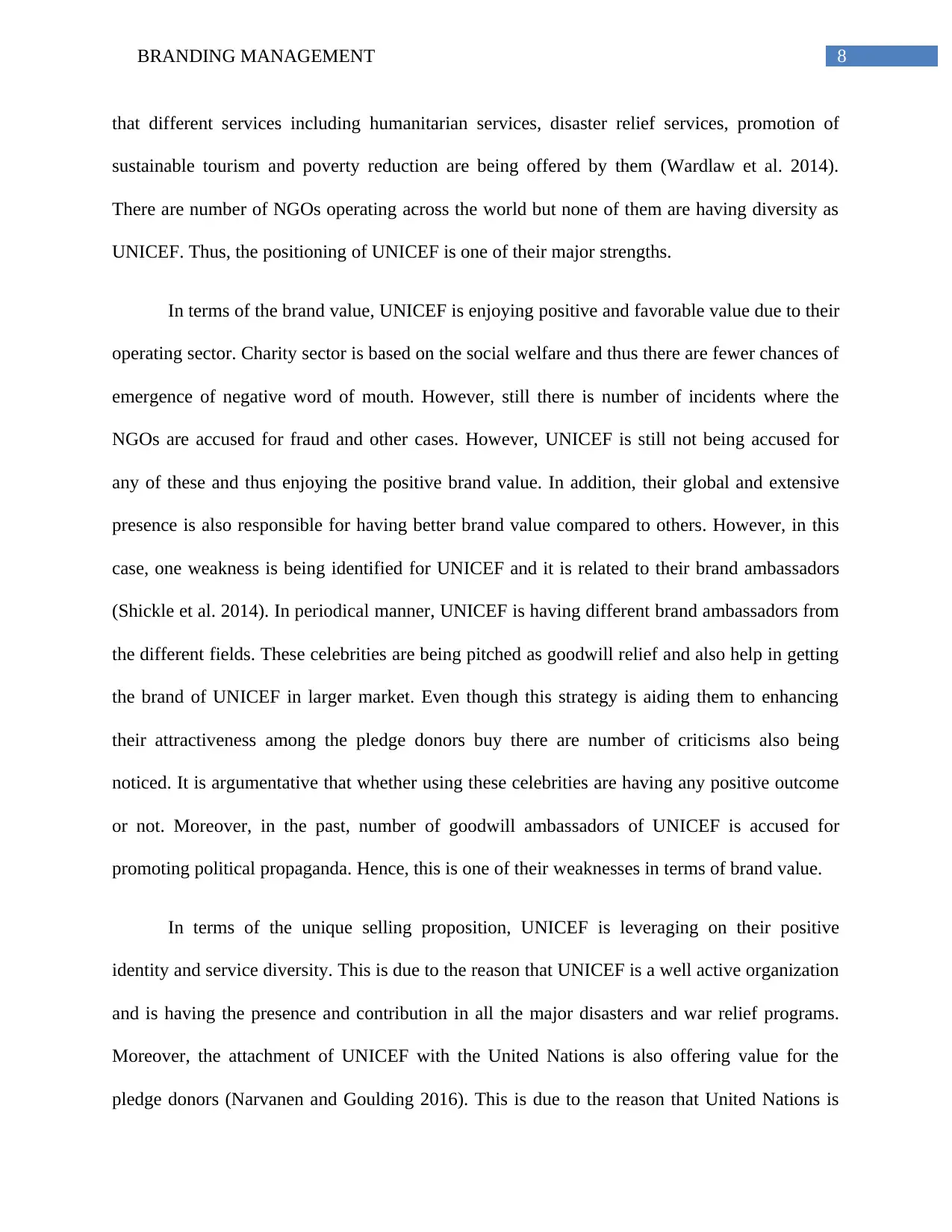
8BRANDING MANAGEMENT
that different services including humanitarian services, disaster relief services, promotion of
sustainable tourism and poverty reduction are being offered by them (Wardlaw et al. 2014).
There are number of NGOs operating across the world but none of them are having diversity as
UNICEF. Thus, the positioning of UNICEF is one of their major strengths.
In terms of the brand value, UNICEF is enjoying positive and favorable value due to their
operating sector. Charity sector is based on the social welfare and thus there are fewer chances of
emergence of negative word of mouth. However, still there is number of incidents where the
NGOs are accused for fraud and other cases. However, UNICEF is still not being accused for
any of these and thus enjoying the positive brand value. In addition, their global and extensive
presence is also responsible for having better brand value compared to others. However, in this
case, one weakness is being identified for UNICEF and it is related to their brand ambassadors
(Shickle et al. 2014). In periodical manner, UNICEF is having different brand ambassadors from
the different fields. These celebrities are being pitched as goodwill relief and also help in getting
the brand of UNICEF in larger market. Even though this strategy is aiding them to enhancing
their attractiveness among the pledge donors buy there are number of criticisms also being
noticed. It is argumentative that whether using these celebrities are having any positive outcome
or not. Moreover, in the past, number of goodwill ambassadors of UNICEF is accused for
promoting political propaganda. Hence, this is one of their weaknesses in terms of brand value.
In terms of the unique selling proposition, UNICEF is leveraging on their positive
identity and service diversity. This is due to the reason that UNICEF is a well active organization
and is having the presence and contribution in all the major disasters and war relief programs.
Moreover, the attachment of UNICEF with the United Nations is also offering value for the
pledge donors (Narvanen and Goulding 2016). This is due to the reason that United Nations is
that different services including humanitarian services, disaster relief services, promotion of
sustainable tourism and poverty reduction are being offered by them (Wardlaw et al. 2014).
There are number of NGOs operating across the world but none of them are having diversity as
UNICEF. Thus, the positioning of UNICEF is one of their major strengths.
In terms of the brand value, UNICEF is enjoying positive and favorable value due to their
operating sector. Charity sector is based on the social welfare and thus there are fewer chances of
emergence of negative word of mouth. However, still there is number of incidents where the
NGOs are accused for fraud and other cases. However, UNICEF is still not being accused for
any of these and thus enjoying the positive brand value. In addition, their global and extensive
presence is also responsible for having better brand value compared to others. However, in this
case, one weakness is being identified for UNICEF and it is related to their brand ambassadors
(Shickle et al. 2014). In periodical manner, UNICEF is having different brand ambassadors from
the different fields. These celebrities are being pitched as goodwill relief and also help in getting
the brand of UNICEF in larger market. Even though this strategy is aiding them to enhancing
their attractiveness among the pledge donors buy there are number of criticisms also being
noticed. It is argumentative that whether using these celebrities are having any positive outcome
or not. Moreover, in the past, number of goodwill ambassadors of UNICEF is accused for
promoting political propaganda. Hence, this is one of their weaknesses in terms of brand value.
In terms of the unique selling proposition, UNICEF is leveraging on their positive
identity and service diversity. This is due to the reason that UNICEF is a well active organization
and is having the presence and contribution in all the major disasters and war relief programs.
Moreover, the attachment of UNICEF with the United Nations is also offering value for the
pledge donors (Narvanen and Goulding 2016). This is due to the reason that United Nations is
⊘ This is a preview!⊘
Do you want full access?
Subscribe today to unlock all pages.

Trusted by 1+ million students worldwide
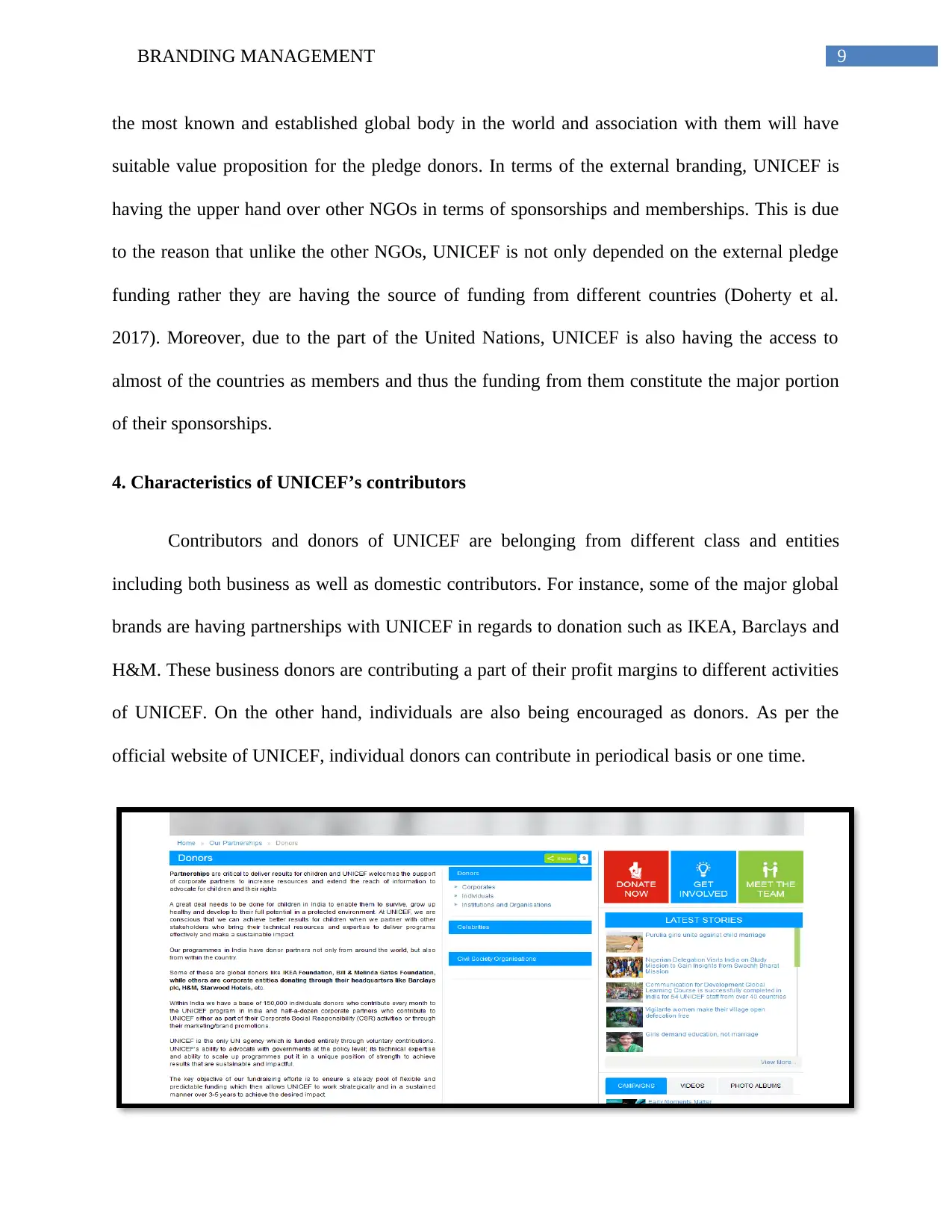
9BRANDING MANAGEMENT
the most known and established global body in the world and association with them will have
suitable value proposition for the pledge donors. In terms of the external branding, UNICEF is
having the upper hand over other NGOs in terms of sponsorships and memberships. This is due
to the reason that unlike the other NGOs, UNICEF is not only depended on the external pledge
funding rather they are having the source of funding from different countries (Doherty et al.
2017). Moreover, due to the part of the United Nations, UNICEF is also having the access to
almost of the countries as members and thus the funding from them constitute the major portion
of their sponsorships.
4. Characteristics of UNICEF’s contributors
Contributors and donors of UNICEF are belonging from different class and entities
including both business as well as domestic contributors. For instance, some of the major global
brands are having partnerships with UNICEF in regards to donation such as IKEA, Barclays and
H&M. These business donors are contributing a part of their profit margins to different activities
of UNICEF. On the other hand, individuals are also being encouraged as donors. As per the
official website of UNICEF, individual donors can contribute in periodical basis or one time.
the most known and established global body in the world and association with them will have
suitable value proposition for the pledge donors. In terms of the external branding, UNICEF is
having the upper hand over other NGOs in terms of sponsorships and memberships. This is due
to the reason that unlike the other NGOs, UNICEF is not only depended on the external pledge
funding rather they are having the source of funding from different countries (Doherty et al.
2017). Moreover, due to the part of the United Nations, UNICEF is also having the access to
almost of the countries as members and thus the funding from them constitute the major portion
of their sponsorships.
4. Characteristics of UNICEF’s contributors
Contributors and donors of UNICEF are belonging from different class and entities
including both business as well as domestic contributors. For instance, some of the major global
brands are having partnerships with UNICEF in regards to donation such as IKEA, Barclays and
H&M. These business donors are contributing a part of their profit margins to different activities
of UNICEF. On the other hand, individuals are also being encouraged as donors. As per the
official website of UNICEF, individual donors can contribute in periodical basis or one time.
Paraphrase This Document
Need a fresh take? Get an instant paraphrase of this document with our AI Paraphraser
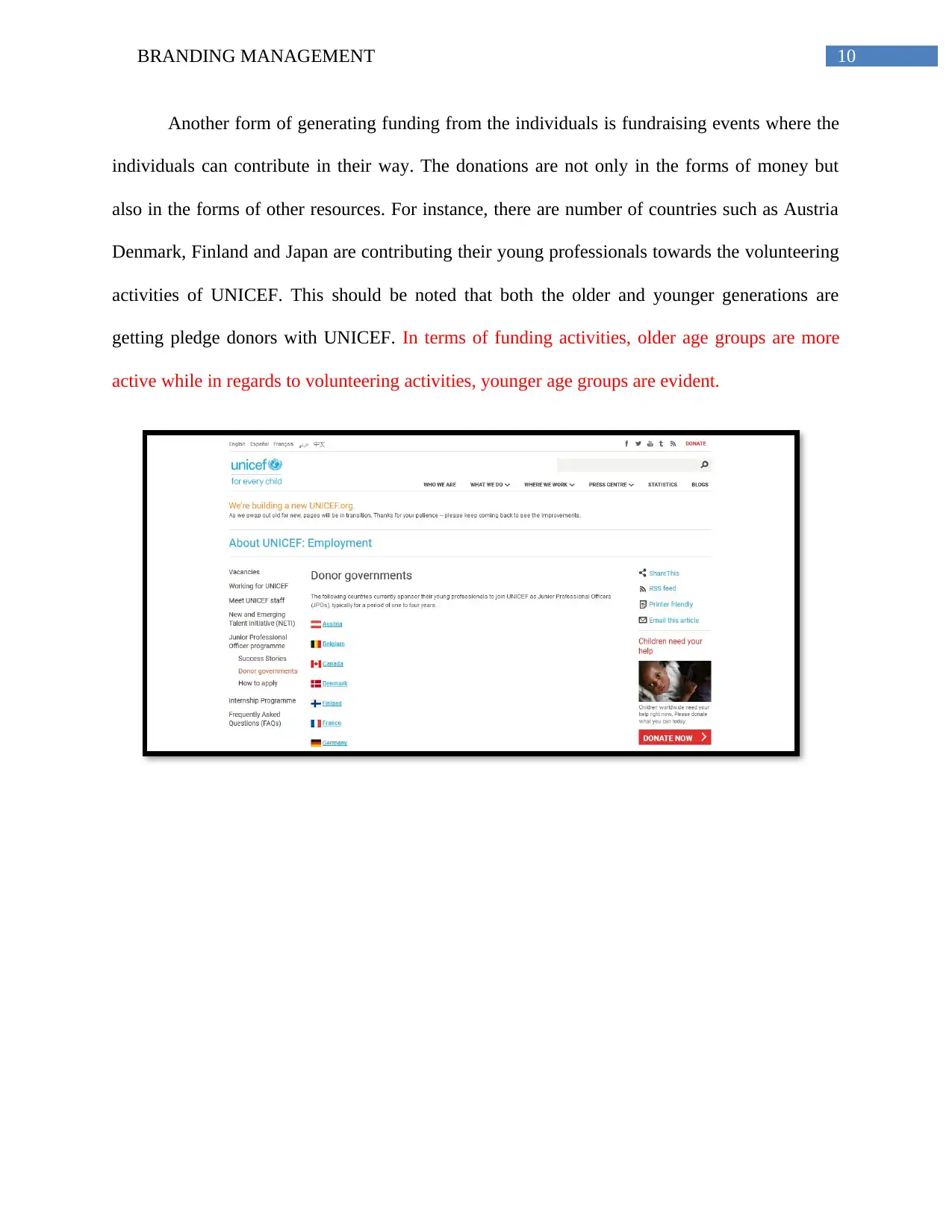
10BRANDING MANAGEMENT
Another form of generating funding from the individuals is fundraising events where the
individuals can contribute in their way. The donations are not only in the forms of money but
also in the forms of other resources. For instance, there are number of countries such as Austria
Denmark, Finland and Japan are contributing their young professionals towards the volunteering
activities of UNICEF. This should be noted that both the older and younger generations are
getting pledge donors with UNICEF. In terms of funding activities, older age groups are more
active while in regards to volunteering activities, younger age groups are evident.
Another form of generating funding from the individuals is fundraising events where the
individuals can contribute in their way. The donations are not only in the forms of money but
also in the forms of other resources. For instance, there are number of countries such as Austria
Denmark, Finland and Japan are contributing their young professionals towards the volunteering
activities of UNICEF. This should be noted that both the older and younger generations are
getting pledge donors with UNICEF. In terms of funding activities, older age groups are more
active while in regards to volunteering activities, younger age groups are evident.
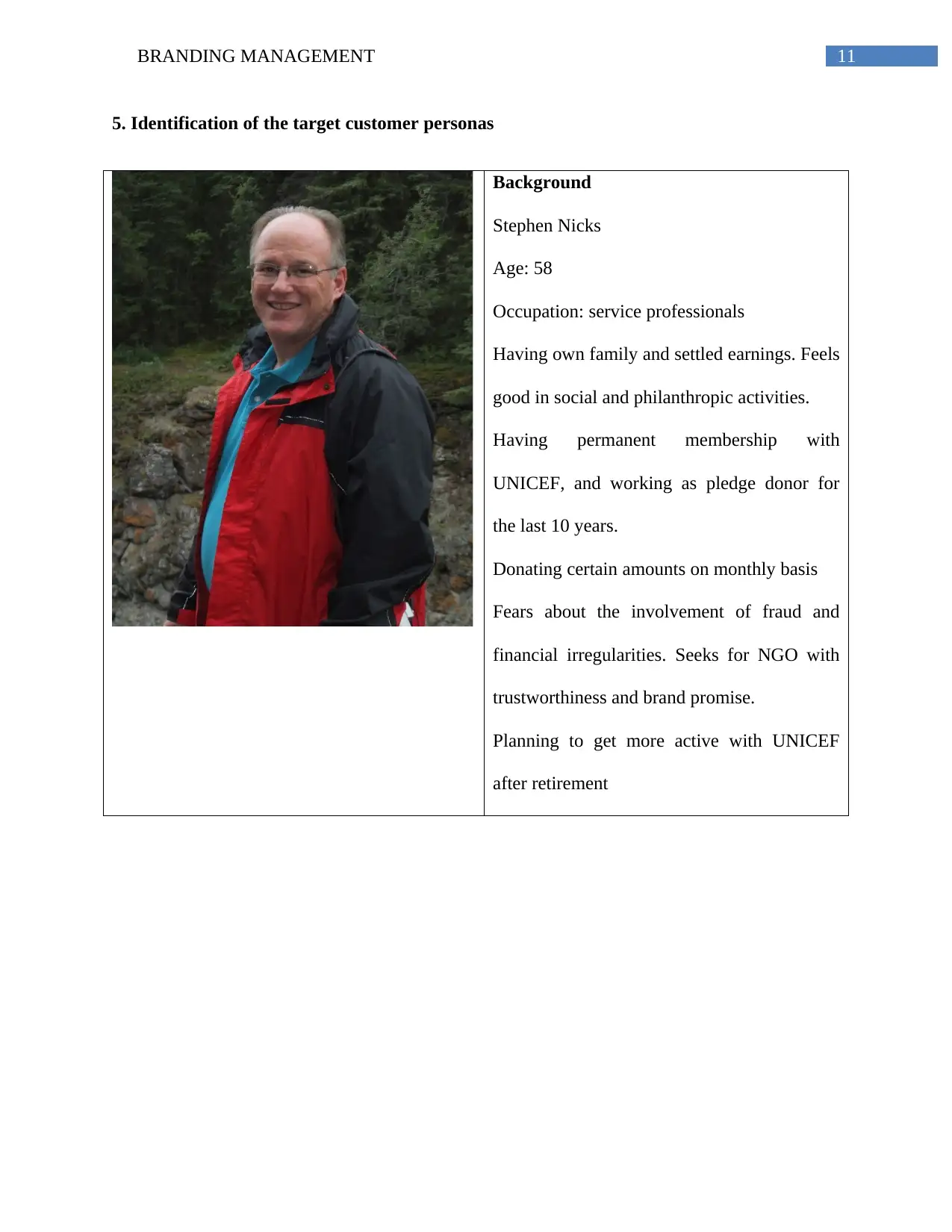
11BRANDING MANAGEMENT
5. Identification of the target customer personas
Background
Stephen Nicks
Age: 58
Occupation: service professionals
Having own family and settled earnings. Feels
good in social and philanthropic activities.
Having permanent membership with
UNICEF, and working as pledge donor for
the last 10 years.
Donating certain amounts on monthly basis
Fears about the involvement of fraud and
financial irregularities. Seeks for NGO with
trustworthiness and brand promise.
Planning to get more active with UNICEF
after retirement
5. Identification of the target customer personas
Background
Stephen Nicks
Age: 58
Occupation: service professionals
Having own family and settled earnings. Feels
good in social and philanthropic activities.
Having permanent membership with
UNICEF, and working as pledge donor for
the last 10 years.
Donating certain amounts on monthly basis
Fears about the involvement of fraud and
financial irregularities. Seeks for NGO with
trustworthiness and brand promise.
Planning to get more active with UNICEF
after retirement
⊘ This is a preview!⊘
Do you want full access?
Subscribe today to unlock all pages.

Trusted by 1+ million students worldwide
1 out of 27
Your All-in-One AI-Powered Toolkit for Academic Success.
+13062052269
info@desklib.com
Available 24*7 on WhatsApp / Email
![[object Object]](/_next/static/media/star-bottom.7253800d.svg)
Unlock your academic potential
Copyright © 2020–2025 A2Z Services. All Rights Reserved. Developed and managed by ZUCOL.
